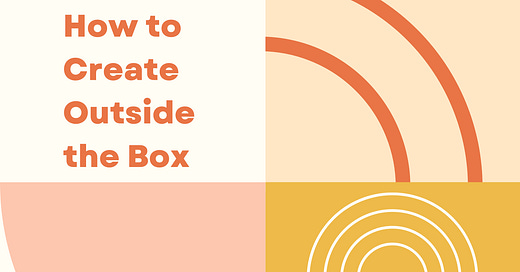Before starting a project, artists and makers must enter the right state of mind.
They think creatively. Some choose from four divergent methods, outlined by Gabriella Rosen Kellerman and Martin E.P. Seligman: integration, splitting, figure-ground reversal, and distal thinking.
After the thrill of a new beginning, innovators invest time and energy, progressing from stage to stage. But how do they maintain the flow of creativity with a mental block? Visionaries don’t give up. They train and reframe their minds with practical exercises.
If you want to create outside the box, let’s get started!
THINK CREATIVELY
Many skilled innovators examine problems from at least four different perspectives:
Integration
Integration involves the assembly of many distinct pieces. The whole is greater than the sum of its parts. Thus, higher levels of meaning are achieved!
Consider a recipe with sugar, unsalted butter, eggs, vanilla extract, all-purpose flour, baking powder, and milk. Individually, these ingredients don’t mean much. However, when you mix and bake them at 350 degrees F for 30-40 minutes, you get a scrumptious vanilla cake. Don’t forget the frosting and sprinkles!
College students open their minds to new possibilities when they pursue subjects outside of a major’s requirements. For example, theater students enrolled in psychology courses will gain valuable insight into human emotions and behaviors. This knowledge is essential for character development.
Forging connections across various disciplines elevates problem-solving abilities.
Splitting
When you care about details, consider splitting. This type of creative thinking occurs when people divide a complex concept into its essential components.
If employees at a thriving business continuously multi-tasked, performing several roles at once, efficiency would plummet. Rather, the most successful working professionals prioritize completing one goal at a time.
Scientists apply splitting to high-level theories, especially those found in quantum mechanics. This field of physics seeks to understand and explain “how extremely small objects simultaneously have the characteristics of both particles (tiny pieces of matter) and waves (a disturbance or variation that transfers energy).”1 If researchers didn’t break down challenging topics into “atom-sized” facts, they would become overwhelmed and frustrated.
Sometimes, the divide-and-conquer strategy works best for a creative endeavor.
Figure-Ground Reversal
The ability to shift focus from a visual’s foreground to its background is known as figure-ground reversal. The illusion alternates between two possibilities.2
When artists and designers demonstrate this technique, they guide perception. Viewers are invited to interact with subjects. At first, they see two silhouetted profiles in black. Upon closer inspection, they witness a white vase in the middle of the picture. Most people can switch back and forth.
Figure-ground reversal is a brilliant cognitive exercise. It shows people that things are not always what they seem. We must dig deeper to uncover their true meanings.
Distal Thinking
Take a moment to envision a radically new future with unforeseen ideas. Welcome to distal thinking.
Savoring the present moment is valuable. Creative geniuses like Leonardo da Vinci imagined inventions hundreds of years in advance. He was the ultimate Renaissance man. By studying machines, da Vinci immersed himself in the world of design and structure. He sketched countless ideas, ranging from the helicopter (aerial screw) and parachute to the self-supporting bridge and robot (automa cavaliere).3
Exceptional distal thinkers explore. They ask questions, research, and investigate. Every experience is an opportunity to enrich their lives.
MAINTAIN CREATIVITY
Once you choose a mode of thinking, it’s easier to generate ideas and solutions.
If you want to maintain a constant stream of creativity, experiment with the following techniques:
STARBURSTING
Draw a star with six points. Each pinnacle should correspond to a series of one-word questions: Who? What? Where? When? Why? How? Fill in the blanks, and see where your answers take you.
DRAW IT AGAIN
Draw the same subject (e.g., cat, cookie, couch, etc.) for seven days straight. By the end of this simple experiment, observe which details changed.
DICTIONARY STORY
Choose a random word from your favorite dictionary. In addition to the first word, highlight the ones that come before and after. Utilize all three words in a short story or article.
READ
Ask your co-worker or friend to recommend a random book. The only rule? The subject matter should venture far beyond your comfort zone. If you're a photographer, try studying chemistry. There are surprising parallels. You don’t have to read every page. Even if you study a paragraph, you might learn something interesting.
COMPOUND COLLABORATIVE
Compound words exist because someone decided to merge two or more words. Examples include classmate, lipstick, fishbowl, and toothbrush. Try inventing a new compound word, by substituting one half for another: squarefish instead of starfish. Let this new combination inspire you to draw or write!
FREEWRITE
When you wake up in the morning, fix your coffee and sit down with a journal. Scribble your stream-of-conscious thoughts, but don’t pause or edit anything. It may be helpful to give yourself 5-10 minutes to fill up a blank page.
THINK BACKWARDS
Start with the end of your journey and work backwards. Many authors use this method to plot their short stories and novels. Every decision and action must support the final goal or destination.
MIND MAPPING
This is considered the ultimate creative brainstorming tool! Start with a central concept. Add branches with words, phrases, or ideas that dive deeper. Take this to the next level with sub-branches. One thought leads to another, which reveals the underlying theme.
Which creative thought and brainstorming techniques would you like to experiment with?
Sometimes, stepping outside is the best way to nurture your creativity. Take a hike. Visit a museum. Meet a friend for coffee. There is a world of possibility waiting for you!








